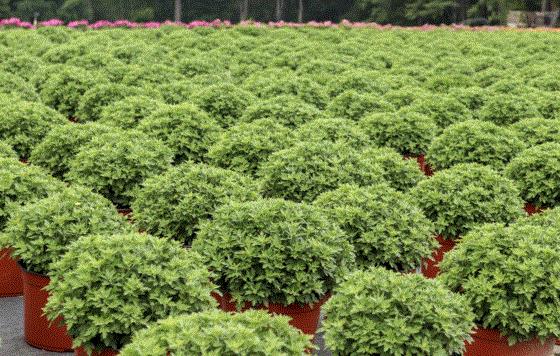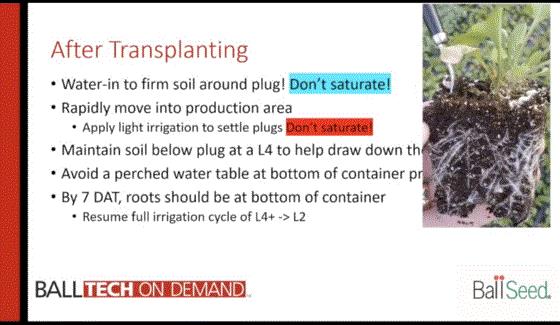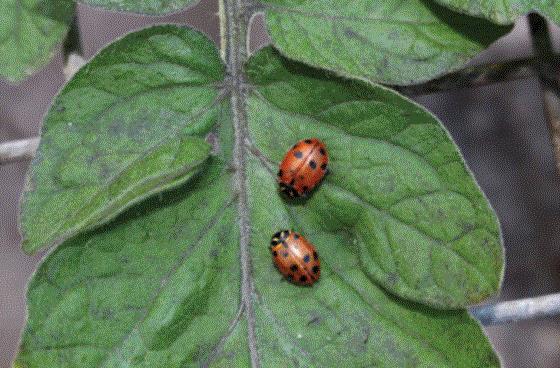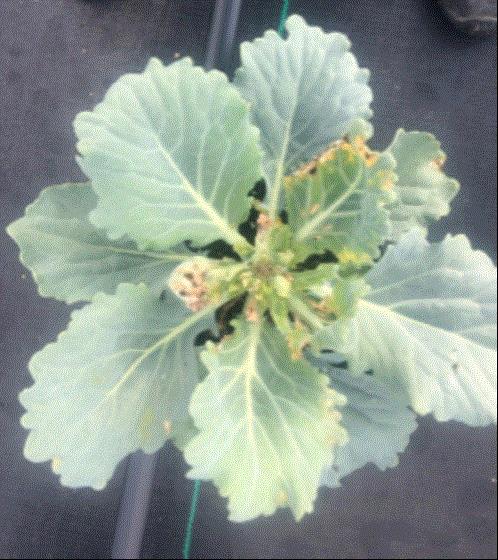Extreme Conditions: Mum Nutrition
If (I should probably say “when”) your mum crop gets hit with extreme heat or onslaughts of rain, managing fertilizer levels can be complicated. Making timely decisions on fertility can make or break the quality of a garden mum crop. Here are some tips from the Tech On Demand team for keeping mums growing to their potential in extreme conditions.

When Mother Nature rears her head, the best solution to managing your feed program starts with identifying your most limiting environmental and cultural factors. Are your crops being grown in a greenhouse or are they outdoors? On constant liquid feed or periodical feeding? Do you use a combination of controlled-release fertilizer (CRF) and water-soluble fertilizer (WSF) to grown your mums or just one of the two?
High Temperatures
-
Under high temp conditions, monitor your crop’s roots and soil EC closely. If the EC gets too high, leach with clear water and retest or reduce your feed rate to avoid root damage.
-
Root damage due to high EC opens the door for root-zone diseases to strike.
-
High temps can cause CRF “dumping,” and your mums will end up getting a fertilizer overdose. This can encourage rapid leaf expansion or potentially burn your roots.
-
Severe dry-down between irrigations can occur easily. For heavy-feeding crops like mums, this greatly increase the chance for fertilizer salt accumulation and root burn.
Heavy Rains
-
Persistent rain on outdoor mums will flush available nutrients out of the growing media.
-
For CRF users, replenishing these nutrients with WSF is critical to prevent nutrient stress (which can lead to crown budding).
-
For any grower who encounters long periods of excessive rain, remember that a wet, well-fed mum is better than a wet, hungry mum. After any heavy rain event, be sure to pump your crops back up with feed, but monitor root health and treat for root rot.
-
Greenhouse growing means no rain flushing all the fertilizer out of your pots. However, prolonged low light and high humidity will reduce nutrient uptake, so monitor soil EC and reduce your feed slightly to avoid root burn.

Nick’s Tip of the Week: To Pinch or Not To Pinch Your Mums
Each week, I’ll work with my buddy Nick Flax, a technical services expert at Ball, to share a concern that’s come up during one of his numerous calls with growers across North America. This week, he’s following up on an article I shared last week about pinching mums. He worked with a colleague to clear up any misconceptions, and I greatly appreciate it.
PROBLEM: In last week’s newsletter, Bill shared a GrowerTalks article from the archives on garden mum pinching written by Dr. Royal Heins. The article covered a lot of excellent points, and focused heavily on mechanical pinching dos and don’ts, as well as implications for pinching mums in blackcloth programs (or “shaded” mum programs, if that’s your flavor). This year, Cindy Drumgool—Ball Mums Product Manager—and I have started getting questions from growers on pinching mums, and we want to speak to a couple of common questions we’ve gotten these past couple of weeks.

NICK’S (AND CINDY’S) TIP: In general, most mum breeders no longer recommend pinching as a standard practice. Recent breeding and selection efforts have focused heavily on robust, natural branching habit, so pinching really should only be done under certain circumstances. Pinching when it isn’t necessary can lead to stunting and delayed finish, poor or non-uniform branching and overall lower crop quality, so the moral of the story is … don’t pinch unless you must.
Here are a couple of scenarios to consider:
“My mum liners came in and they’re really tall! Should I pinch them before I plant them or after I plant? Should I pinch them at all?”
Yes, maybe, and possibly no. It all depends on the quality and how well-developed they are.
-
If liners look like they stayed in the prop house for a week or two longer than they should have (i.e., lots of nodes and very tall), a pinch may be beneficial. If planting one plant per pot (ppp) into a 6- to 8-in. pot, pinch back to 5 to 7 nodes. You can pinch back to 8 to 10 nodes if you’re doing 1 ppp in larger pots and have a long crop time, but lateral shoots may break less evenly (that’s what happens if you pinch too softly) and most containers larger than about 8-in. would be better off having 2 to 3 ppp anyway, simply to reduce crop time.
-
If liners are leggy, soft and look like they only had two weeks in propagation (at best) before they shipped (i.e., thin stem and only 4 to 6 nodes total), pinching is not a good option. If you pinch back to 2 to 4 nodes just to shorten them to an “appropriate” height, your crop may stall and need more time to fill out. The best alternative in this situation is to plant your liners deeply. This will reduce potential stem breakage and keep them from toppling over as they grow.
“My liners showed up today and a bunch of the stems broke during shipping. Should I pinch the broken ones and leave the intact ones as they are?”
You can leave the intact liners as they are and just pinch the damaged ones, but this means there will likely be some noticeable variability in finished plant size. They’ll all fill out if pinched plants have an appropriate number of nodes left and you feed heavily starting from transplant, but there will likely be noticeable difference in shape and overall size between pinched and non-pinched plants. Crop uniformity is king, so this may leave some of your wholesale customers wondering, “What’s up with those different-looking mums?” and impact sell-through.
-
If more than 75% of liners are broken or damaged, you would likely be better off pinching everything simply to preserve uniformity. If you do this, take steps to ensure they rebound as quickly as possible—especially if the breeder instructions say “No pinch.” Even if your crop doesn’t fill out as quickly or as much as you’d like, everything will be uniform.
-
If about 50% of liners are damaged, make your decision based on any potential standing orders or contracts that you have with customers. If a contract or order you have demands a large finished spec, do some quick math. Will the number of undamaged liners you have be enough to fill the order?
-
If you have enough undamaged liners to complete your order, only pinch the damaged ones to a uniform number of nodes and leave the rest as they are. Be sure to group the pinched vs. non-pinched plants in your production areas to account for difference in water or mineral nutrition demands.
-
If there aren’t enough undamaged liners to fill your “big mum” order, pinch everything back to a uniform node number and prepare to push your crop heavily. Start by feeding with a 20-20-20 at 300+ ppm N several times to really soften-up those axillary nodes and encourage shoots to break. Monitor soil EC to ensure nutrient availability does not fall behind (keep EC at around 2.5 mS/cm) and keep your crop moving.
-
If a small number of liners are damaged, you’re better off not pinching the whole group. Again, pinch the damaged one back to a uniform number of nodes and group them to account for difference in growth rate and input needs. Focus your efforts on the main crop and, with any luck, you might get those couple of stragglers caught up by the time your main crop is finished.

Pansy Season Videos: Transplanting & Finishing
We have two videos to help you and your team nail this year’s fall pansies. Both are great resources to share with the entire crew so everyone is on the same page when it comes to transplanting and finishing the crop.
In the RECEIVING & TRANSPLANTING VIDEO, Dr. Will Healy covers the stage when you receive plugs and transplant them into finished containers by focusing on greenhouse environment and crop culture. He starts with tips and strategies for receiving plugs in an effort to minimize risk with young plants. Then he moves into the processes to put in place prior to transplant, such as sanitation, temperature and relative humidity management and nutrition. Finally, he covers what your team needs to know immediately following transplant by digging deep into irrigation and nutrition.

When it comes to FINISHING your fall pansy crop and sending it off to your retail or landscape customers, Will starts with a discussion of Pansy Mottle Syndrome (what to watch for and how to mitigate the risk) before tackling common grow-out issues. He talks about ways to speed up a crop, as well as strategies to slow your pansies down. The finishing stage is not a time to deal with disease, so Will talks about prevention and control tactics. Finally, he offers suggestions for post-harvest prep, with the goal of shipping the best crop possible out the door.
If you prefer to listen to these discussions in audio-only format, we’ve got you covered. Both are available as Tech On Demand podcasts, brought to you by GrowerTalks. You can find the podcast on all major apps like Apple Podcasts, Spotify, Audacy, Google, Stitcher and more. Just search “Tech On Demand GrowerTalks.” If you’d prefer, just visit our WEBSITE for all episodes. Be sure to hit the subscribe button so you never miss an episode.

Young Growers on Facing 2022’s Challenges: A FREE Webinar!
Meet the three finalists for this year's Young Grower Award in a live Zoom interview on Tuesday, June 28, 2022 at 1:00 PM Eastern Time / Noon Central. REGISTER NOW!
Hear from Quinten Henning of Henning's Farm & Greenhouse in DeMotte, Indiana; Mike Krueger from Midwest Groundcovers in St. Charles, Illinois; and Erika Ramos of J. Berry Nursery in Grande Saline, Texas.

You’ll learn how these young professionals dealt with the challenges of Spring 2022 and their opinions about where our industry is headed from here. GrowerTalks editor Chris Beytes, the fearless host, will chat with the finalists about:
-
Their strategies for overcoming supply chain issues
-
How they've handled the labor shortage pre- and during the pandemic
-
A recap of Spring 2022 in their area
-
And much more … including your questions!
Special thanks to the award sponsors, Ball Horticultural Company and AmericanHort.
Indirect Effects of Parasites & Predators
A new article from Dr. Raymond Cloyd, a professor and extension specialist at Kansas State University and all-around insect pest guru, dug into a topic I’m not sure if we’ve heard much about and certainly one that’s very interesting. In the latest issue of GrowerTalks, Dr. Cloyd submitted NON-CONSUMPTIVE EFFECTS OF BIOLOGICAL CONTROL AGENTS, which discusses how parasitoids and predators released into greenhouses to consume pests can also have effects beyond “eating” the other bugs.

These are “non-consumptive” effects, such as causing defensive behaviors in the pests that can even lead to them just “dropping off” foliage into the soil or simply leaving the plants altogether. Obviously, I’m grossly oversimplifying this research, but from what I understood reading the article, these non-consumptive effects are generally positive, but can also have some less-desirable consequences.
Before I completely butcher the science behind this phenomenon, why don’t you click the link above and read the full story. It’s truly interesting information, and if you use predatory biocontrols, you’ll want to know all of the effects, including the ones detailed by Dr. Cloyd.
I’ll end with his final conclusion: Although the non-consumptive effects of commercially available biological control agents released into greenhouse production systems aren’t well known, greenhouse producers should be aware of the potential non-consumptive effects of biological control agents in managing insect and mite pest populations, and subsequently reducing damage to greenhouse-grown crops.

Tech Tip: Calcium Deficiency in Cabbage & Kale

Here’s an issue the Tech On Demand team encountered last year that I’ll share to help you avoid running into the same problem with your fall kale or cabbage crop. When the team saw the photo to the right, they knew right away the crop was deficient in calcium.
Young leaf distortion and tip atrophy (when the tip stops developing) are signs of calcium (Ca) deficiency in flowering cabbage and kale. These plants have a very high requirement for Ca if you want normal leaf development. The plants will start by having translucent, water-soaked areas on the margin of the leaves. After a short period, the margins will burn, and the leaves will be distorted and fail to size up. The younger leaves will stop any normal development and will become stunted.
One diagnostic description of Ca deficiency is “little leaf syndrome,” which is related to the requirement for Ca to promote normal leaf expansion. With severe Ca deficiency, the tip becomes atrophic and growth stops. This problem is more severe when relative humidity (RH) and night temperatures are high. Once the temperatures or RH decline, the plant resumes normal growth.

Finish Line …
Mums, cabbage and kale, fall pansies, poinsettias … it’s a busy time of year. Not to mention kids and grandkids are out of school and summer trade show season is upon us. Now’s the time of year you probably aren’t sitting at your desk watching videos and reading articles. It’s a good thing I’ve hosted almost 100 podcast episodes for you to put on while walking crops or driving to activities!
TECH ON DEMAND, BROUGHT TO YOU BY GROWERTALKS
STEM: INSIDER TIPS FOR GREENHOUSE PROS
Both of these podcasts are available on all the major apps (like Apple Podcasts, Spotify, Audacy, Stitcher, TuneIn, etc.). And as of just this week, the Tech On Demand episodes are also available on YOUTUBE. That’s hours and hours of listening pleasure, packed with information from industry experts to help arm you with the knowledge you’ll need to tackle challenges every season.
If there are topics you’d like to see covered in future episodes, let me know! Shoot me an EMAIL or catch me at Cultivate and I will do my best to find the most appropriate guest experts.



Please feel free to send your comments, constructive criticism and topic ideas to me at bcalkins@ballhort.com.

Bill Calkins
Editor - Tech On Demand
This email was received by you and 25,894 other fine subscribers!
If you're interested in advertising in Tech On Demand, contact Kim Brown ASAP and she'll hook you up.